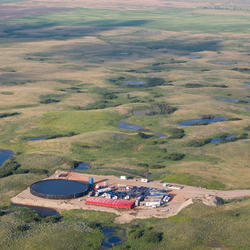Methods Development
Methods Development
Filter Total Items: 27
Energy Integrated Science Team
The Energy Lifecycle Integrated Science Team focuses on the potential for contaminant exposures in the environment that might originate from energy resource activities including, extraction, production, transportation, storage, extraction, waste management and restoration. Perceived health risks to humans and other organisms will be distinguished from actual risks, if any. If actual risks are...
Technique Used to Distinguish Natural Background from Human-Caused Enrichment of Trace Elements in Soils
Human activities can enrich toxic trace elements like uranium and arsenic in the environment, but these elements also are from natural sources and occur at background levels. Scientists utilized a technique that identifies the background and the elemental fingerprint of human-caused enrichment and tested the new technique on data collected near uranium mines in Arizona.
Can There be Unintended Benefits when Wastewater Treatment Infrastructure is Upgraded?
Science from the U.S. Geological Survey (USGS) and other entities has shown that a mixture of natural and synthetic estrogens and other similar chemicals are discharged from wastewater treatment plants (WWTPs) to streams and rivers.
Food Resources Lifecycle Integrated Science Team
The team studies the movement of toxicants and pathogens that could originate from the growing, raising, and processing/manufacturing of plant and animal products through the environment where exposure can occur. This information is used to understand if there are adverse effects upon exposure and to develop decision tools to protect health.
Minerals Science Team
The Minerals Integrated Science Team focuses on contaminant exposures in the environment that might originate from mineral resource activities including, transportation, storage, extraction and waste management. Perceived health risks to humans and other organisms will be distinguished from actual risks, if any. If actual risks are identified the science produced by this team can inform how to...
Unique Methods Used to Understand Frog Exposure to Pesticides in Agricultural Settings
Adult frog exposure to pesticides in aquatic and terrestrial habitats was quantified using a novel combination of radio telemetry and passive sampling techniques to better understand factors affecting frog health and survival in agricultural landscapes.
Bioactive Chemicals Research Laboratory
The Bioactive Chemicals Research Laboratory applies a collaborative transdisciplinary approach to conduct research to minimize the risk to human and aquatic organism health from exposure to contaminants in water supplies.
Michigan Bacteriological Research Laboratory
Microbiologists at the Michigan Bacteriological Research Laboratory (MI-BaRL) use a wide array of traditional and modern molecular approaches to evaluate microbial pathogens and antimicrobial resistance pathways in the environment.
Environmental Chemistry Core Technology Team
About the Research The Environmental Chemistry Laboratory Core Technology Team (CTT) as part of the Environmental Health Program develops and applies innovative methods of sampling and analysis to answer critical questions about the occurrence, distribution, fate and transport, and biological exposure of chemical in all environmental matrices (water, air, tissues, sediments, and others).
New Method Can Measure Naturally Occurring Element Exposure in Hummingbirds Without Harm
Seventeen naturally occurring trace elements, including those associated with adverse health impacts when birds are exposed to toxic levels (iron, lead, mercury, selenium, zinc, cadmium, and arsenic) were measured in small birds without harm. The nonlethal method was developed for hummingbirds, with Anna's hummingbirds ( Calypte anna ) as a test species and can be more broadly applied to other...
Endocrine Disrupting Compounds in the Chesapeake Bay Watershed Science Team
The Chesapeake Bay is the largest estuary in the United States and provides critical resources to fish, wildlife and people. For more than a decade, recreational fish species have been plagued with skin lesions and intersex conditions (the presence of male and female sex characteristics in the same fish) that biologists attributed to exposures to endocrine disrupting chemicals (EDCs)...
U.S. Geological Survey Scientist Recognized as Highly Cited Researcher
U.S. Geological Survey (USGS) scientist Dr. Edward T. Furlong has been designated a Thomson Reuters Highly Cited Researcher, ranking among the top 1 percent of researchers from 2003 to 2013 for most cited documents in their specific field (Environment/Ecology). He was listed in Thomson Reuters' "The World's Most Influential Scientific Minds 2015" report.













